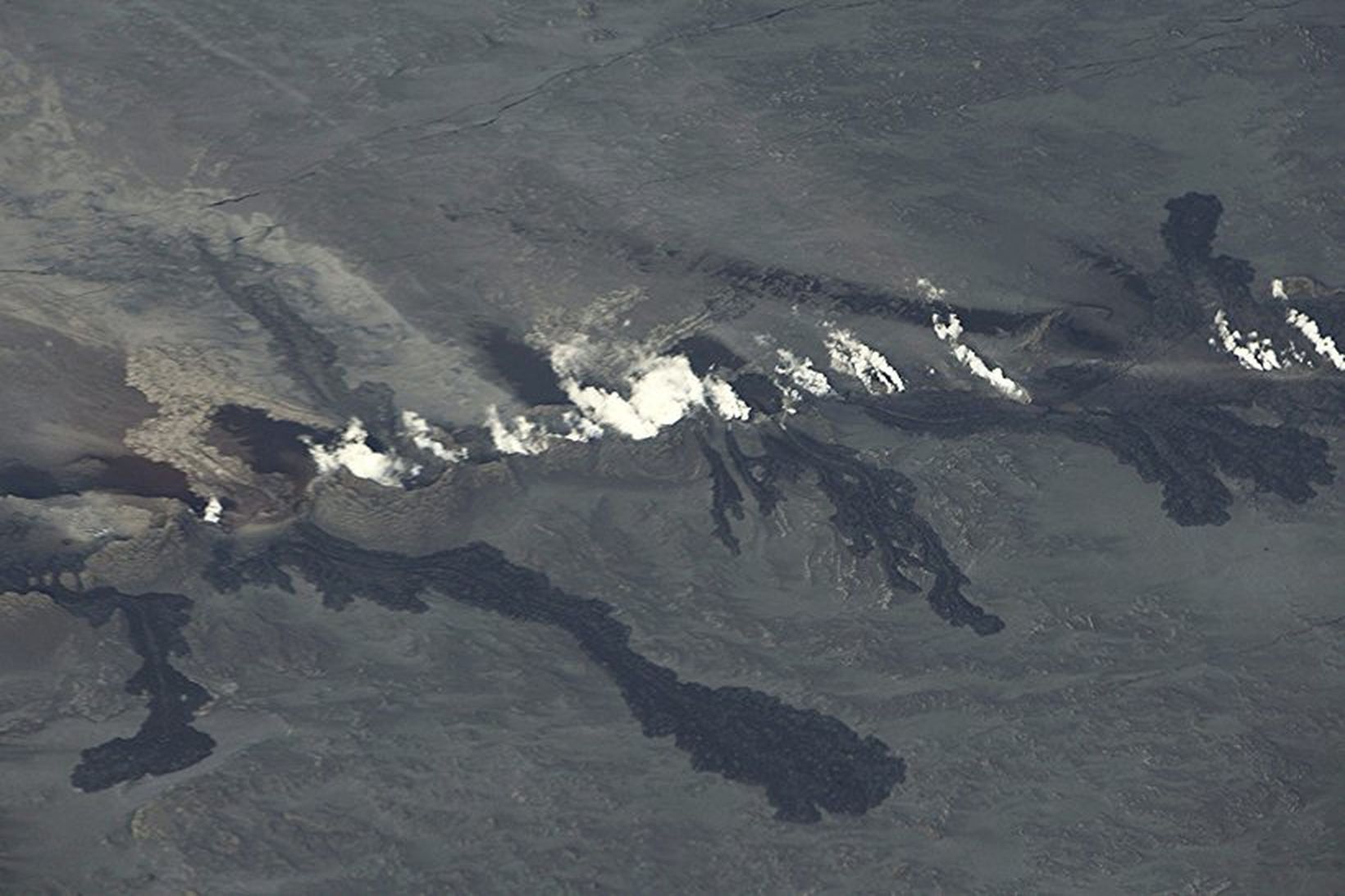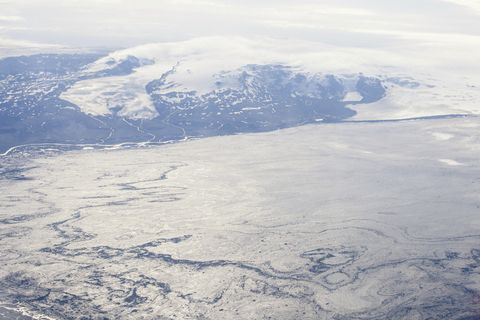Four scenarios likely around Bárðarbunga
The Holuhraun eruption site. The rift extends 1.000 meters.
Golli / Kjartan Þorbergsson
Scientists from the Icelandic Met Office, the Institute of Earth Science and representatives from the Civil Protection Department met this morning to go over the situation in the area around Bárðarbunga, Dyngjujökull and Holuhraun.
The key points of their meeting are:
- Seismicity remains high with over 700 quakes since midnight, counted at 11:45 GMT.
- The most powerful earthquakes in the area since midnight were a magnitude 4,5 quake in northern Bárðarbunga around 02:35, a magnitude 4,2 earthquake in the same area at 06:18 and 5,4 magnitude earthquake at 07:03 on the southern edge of Bárðarbunga. All times are GMT.
- Around 20 earthquakes have hit around Askja. Outflow of magma into the dyke could explain these tremors.
- Jökulsá á Fjöllum, as well as other rivers north of Vatnajökull show no signs of change in water flow.
- Scientists are examining the fresh lava from Holuhraun.
Currently, there is no way of telling what will happen. Four likely scenarios are given:
- Inflow of magma into the dyke from Bárðarbunga will stop, resulting in the event slowly fading out with no further eruptions.
- The dyke will again break through to the surface north of Dyngjujökull, possibly in a different area than last time but not under Dyngjujökull.
- The dyke might break through under Dyngjujökull, resulting in a jökulhlaup and significant ash fallout.
- An eruption in Bárðarbunga, resulting in a jökulhlaup in Jökulsá á Fjöllum, but also possibly in Skjálfandafljót, Kaldakvísl, Skaftárkatlar and Grímsvötn.
Other scenarios are also possible.
The aviation code over Bárðarbunga remains orange and yellow over Askja.
Fleira áhugavert
- Entire Blue Lagoon car park now covered in lava
- Photos: The lava at the parking lot of the Blue Lagoon
- Live feed from the eruption
- Lava coming from three craters: Activity stable
- Photos: Natural threshold is taking over
- Part of the parking lot covered by lava: Impossible to assess damage
- About 200 people have been evacuated from the Blue Lagoon
- People were staying in 20 houses in Grindavík
- A map of the approximate location of the fissure
- "We were rather expecting a red Christmas"
- Entire Blue Lagoon car park now covered in lava
- Photos: The lava at the parking lot of the Blue Lagoon
- Live feed from the eruption
- Part of the parking lot covered by lava: Impossible to assess damage
- Lava coming from three craters: Activity stable
- About 200 people have been evacuated from the Blue Lagoon
- Photos: Natural threshold is taking over
- A map of the approximate location of the fissure
- People were staying in 20 houses in Grindavík
- Volcanic eruption at Mt Stóra-Skógfell
- Entire Blue Lagoon car park now covered in lava
- Photos: The lava at the parking lot of the Blue Lagoon
- Live feed from the eruption
- Part of the parking lot covered by lava: Impossible to assess damage
- About 200 people have been evacuated from the Blue Lagoon
- A map of the approximate location of the fissure
- Lava coming from three craters: Activity stable
- Volcanic eruption at Mt Stóra-Skógfell
- Photos: Natural threshold is taking over
- "Iceland is in a unique situation"
Fleira áhugavert
- Entire Blue Lagoon car park now covered in lava
- Photos: The lava at the parking lot of the Blue Lagoon
- Live feed from the eruption
- Lava coming from three craters: Activity stable
- Photos: Natural threshold is taking over
- Part of the parking lot covered by lava: Impossible to assess damage
- About 200 people have been evacuated from the Blue Lagoon
- People were staying in 20 houses in Grindavík
- A map of the approximate location of the fissure
- "We were rather expecting a red Christmas"
- Entire Blue Lagoon car park now covered in lava
- Photos: The lava at the parking lot of the Blue Lagoon
- Live feed from the eruption
- Part of the parking lot covered by lava: Impossible to assess damage
- Lava coming from three craters: Activity stable
- About 200 people have been evacuated from the Blue Lagoon
- Photos: Natural threshold is taking over
- A map of the approximate location of the fissure
- People were staying in 20 houses in Grindavík
- Volcanic eruption at Mt Stóra-Skógfell
- Entire Blue Lagoon car park now covered in lava
- Photos: The lava at the parking lot of the Blue Lagoon
- Live feed from the eruption
- Part of the parking lot covered by lava: Impossible to assess damage
- About 200 people have been evacuated from the Blue Lagoon
- A map of the approximate location of the fissure
- Lava coming from three craters: Activity stable
- Volcanic eruption at Mt Stóra-Skógfell
- Photos: Natural threshold is taking over
- "Iceland is in a unique situation"




/frimg/1/53/8/1530844.jpg) Myndir: Náttúrulegur þröskuldur að taka við
Myndir: Náttúrulegur þröskuldur að taka við
 Yfir 300 stæði fóru undir hraun
Yfir 300 stæði fóru undir hraun
 Hraun kemur úr þremur gígum: Virknin stöðug
Hraun kemur úr þremur gígum: Virknin stöðug
 Vika í kosningar: Þetta segja kannanir
Vika í kosningar: Þetta segja kannanir
 Viðræður ekkert þokast frá því á þriðjudag
Viðræður ekkert þokast frá því á þriðjudag
 Reiðubúin að aflýsa verkföllum í fjórum leikskólum
Reiðubúin að aflýsa verkföllum í fjórum leikskólum
/frimg/1/53/8/1530849.jpg) Fatlaður drengur fær ekki þjónustu í verkfalli
Fatlaður drengur fær ekki þjónustu í verkfalli
